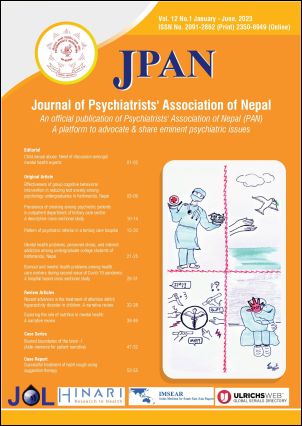Pattern of psychiatric referral in a tertiary care hospital
DOI:
https://doi.org/10.3126/jpan.v12i1.59420Keywords:
Psychiatric referral, Co-morbidities, Liaison PsychiatryAbstract
Introduction: Global mental health challenges persist amidst a rising trend of patients seeking consultations with non-psychiatric specialists, driven by stigma and a lack of awareness. This study aims to study the demographic profile of patients referred to the Department of Psychiatry and Mental Health from other departments, referral sources, prevalent psychiatric disorders, and explores potential associations with co-existing physical conditions.
Material and Method: A six-month descriptive cross-sectional study (October 2022 to March 2023) was done at Birat Medical College Teaching Hospital using total enumeration sampling method. Patients referred to Psychiatry were assessed using the International Classification of Diseases, Tenth Revision, Diagnostic Criteria for Research (ICD-10 DCR). Data were analyzed with SPSS version 25, utilizing mean, standard deviation for continuous data, and frequency, percentage for categorical data. Odds ratios were computed for associations.
Results: Among 160 patients, the majority were male (55%), Hindu (90%), married (78.1%), and educated up to secondary level. Department of Medicine accounted for the highest referrals (50%) primarily for fearfulness (21.3%). Neurotic, stress-related and somatoform disorders were most common (33.1%), followed by mood disorders (28.8%). No significant association was found between psychiatric disorders and physical illnesses.
Conclusion: The Department of Medicine was the most common referring department, with neurotic stress-related and somatoform disorders being the prevalent diagnosis. Referral to Psychiatry facilitates early recognition and treatment of undiagnosed psychiatric conditions, advocating for routine practice among non-psychiatric specialists. Future research should target barriers and interventions to improve psychiatric service utilization in Consultation-Liaison Psychiatry settings.
Downloads
Downloads
Published
How to Cite
Issue
Section
License

This work is licensed under a Creative Commons Attribution 4.0 International License.
This license enables reusers to distribute, remix, adapt, and build upon the material in any medium or format, so long as attribution is given to the creator. The license allows for commercial use.




